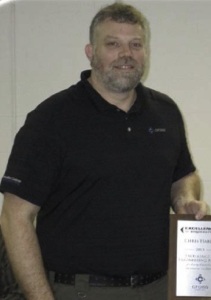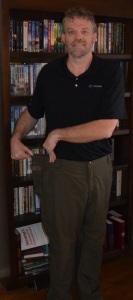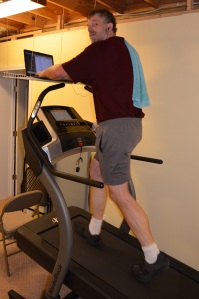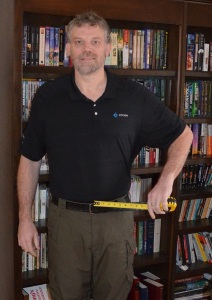Thinking I was wasting my time, in February 2014 I went for a physical exam to get that health coverage discount. I hadn’t been in a decade – I already knew I was 42, obese, with high blood pressure, and at risk to develop diabetes. I had already tried exercise and had the injuries to show for it. I had tried several diets of the “never eat this” variety – I’d lose 20-30 pounds and then plateau far above my target weight, hating every minute of the deprivation of “never eating this.” I didn’t want to handle it with drugs or surgery. What could the doctor possibly tell me that I didn’t already know?

The Short Version
I told the doctor I’d like to improve my health through diet and exercise but hadn’t had much success. He advised I try “Dr. Squat’s Zig-Zag Diet”: you count Calories to eat around 80% of your BMR (base metabolic rate) for 5½ days a week, followed by 1½ days of eating more. I have lost over 100# and drastically improved my blood chemistry over the past year with that diet concept plus walking slowly uphill on treadmills, without wearing out my joints. A plan to indulge at a specific time in the near future makes it much easier for me to exercise self-control in my diet. I find success to be incredibly motivating toward continued success.
Keep reading if you want details…

Everyone is Unique
We all have different metabolisms, ages, injuries, and preferences. We have different beliefs and goals regarding sugar, artificial sweeteners, gluten, GMOs, organic & local food, the health implications of various kinds of fats and carbs, etc. We get absorbed in or bored with different things. Some people can control their weight by following hunger cues or with exercise alone; others (like me) can’t trust our hunger, can always out-eat our exercise & must count Calories. We have different work schedules, travel requirements, and commitments to family and community.
My goal here is to document what has worked for me, knowing that nobody else has my exact set of circumstances; therefore this precise plan will not work as well for anyone else. My desire is that people adapt any small aspect of this piece into their own plans to become more fit.
My Dad
I am built like my father, only bigger – he had a heavy 6’3″ frame, and I have a heavier 6’6″ frame. Much of my motivation comes from having watched his suffering in his later years. He injured his knees in college and through the wear & tear of jogging in his 20s and 30s. His injured knees then made it painful to exercise as he got older, so while he frequented the gym and did his best to stay in shape, he put on a lot of weight in his later years. Although his blood pressure and cholesterol meds kept his blood-work numbers where the doctors wanted them, he died suddenly from a heart attack a month short of his 70th birthday. That was better than his older brother (killed by his fourth heart attack at 53) and his father (debilitated by a stroke at 61).
So … with those genetics against me, I am motivated to keep the weight off in a way that maximizes the useful life of my joints, and improve my cardiovascular health without resorting to drugs which may be treating symptoms rather than the causes of cardiopathy and death.

The Diet Plan
The best “diet” is a plan that you will actually follow for the long term!
I stuck pretty close to Dr. Squat’s Zig-Zag Diet (http://drsquat.com/content/knowledge-base/zigzag-diet) for 4-5 months, eating 1800-2000 Calories (really kcal) on my strict days. I started by doing 30-40 minutes a day on a bike or treadmill with 2-3 rest days a week. Once I got into better shape, I increased that to over an hour a day, typically burning anywhere from 900-1200 Calories 5-6 days per week. I also read other sources, particularly http://scoobysworkshop.com. Keeping the same concept, I changed my diet so I was eating more like 2500 Calories daily (around my BMR), and having a HCHD (“high-Calorie half-day”) every 3rd or 4th day. I prefer that – I don’t get as hungry on my strict days, and I find a ½ day of pigging out to be very satisfying, while 1½ days was belly-bloating overkill.
Both plans allowed me to consistently lose 6-8 pounds per month once I got past the initial quick drop that you get on starting any diet. I wanted to lose fat while retaining as much muscle as possible – I’ve read that losing more than 2#/week is unhealthy and a recipe for muscle loss. Therefore I adjusted my strict-day Calories intake to maintain that rate of loss.
I don’t count Calories on my HCHDs. I still sharply limit free sugar (added processed sugar and/or natural sugar separated from much of its source such as in juice or dried fruit) to around 2-3 servings per month. That is due to my understanding of what free sugar does to our overall health – I am sure it’s possible to lose the amount of weight I lost by substituting free sugar for some of the fresh fruit I ate. I also sharply limit trans-fats & anything with “…hydrogenated…” in the ingredients list. Otherwise I eat what I want until I’m full – meat with lots of cheese, pizza, burgers, bread, bacon, eggs, sausage, whatever.
On strict days, I ate around 40% of my Calories as protein, and 30% each in fat and carbs. I recently switched to 20% carbs and 40% each of fat and protein … that seems to satisfy my hunger better. I eat a moderate amount all kinds of fats other than trans-fats. The majority of my protein comes from canned, grilled or BBQed chicken. I also eat some eggs and lean steak almost every day. My carbs come from fruit (2-3 bananas or their equivalent in apples, strawberries or other fruit), broccoli, and refried beans. Some fat comes with the meat, but almost half comes from almonds, which I sometimes mix with dark chocolate pudding. I also allow about 150 unallocated Calories for the evening of strict days … I can have an extra banana, a handful of nuts, or a bit of butter, cheese or corn chips with dinner.
My research indicates that the low-fat, high-carb recommendations from the 1950s and 1960s are horribly misguided and proceeded from fatally flawed studies. And low sodium recommendations would be better aimed at the small minority of the population who get high blood pressure due to a sodium sensitivity, not everyone else. In the months leading up to my last blood test (see below), my strict-day diet included 15 grams of saturated fat (just within the AHA’s recommendation), 600 mg of cholesterol (double AHA’s), and 9000 mg sodium (6 times AHA’s recommendation of 1500). I consume even more of those on HCHDs. But I trust the recommendations to eat between 0.7 and 1 grams of protein for every # weight, and to eat a gram of fiber for every 70 total Calories. My diet reaches each of these goals with room to spare (to make up for “whatever I want” during HCHDs).
I drink a lot of water (5-7 liters per day) and I usually put an Airborne tablet in each liter for vitamin C and flavor.
The Exercise Plan
The best exercise program is one that you will actually follow for the long term.
My wife and I already had a recumbent stationary bike, on which I had been sporadically exercising before I started this program. Initially I got more serious about using it, but it’s important to exercise bearing one’s weight as much as possible (obviously foot, leg and back injuries may limit that – thankfully my previous heel, ankle and knee injuries had healed before I started this plan). I didn’t want to spend a lot of time jogging (see “my Dad” above). On a week-long business trip soon after I started this plan, I got on the hotel’s treadmill, raised the elevation up to the maximum 15% and walked. Even walking just 2 mph kicked my tail. The raised elevation worked my muscles hard while reducing the frequency and intensity of impacts to my joints (relative to level walking or running). Soon after, we ordered a treadmill with an elevation that goes all the way up to 40%. Now that I’m in better shape, when I’m at home I walk 2-2.5 mph on a 20-30% incline. When I’m on the road, I try to stay at a hotel with a fitness center. Typical treadmills go up to 10%, 12% or 15% – I raise them all the way up and walk 2.5-3.5 mph.

I track minutes and miles walked, Calories burned, and elevation rise over the walk. Over the past 8 months I have climbed the equivalent of 70 vertical miles total, well above the altitude of the 62-mile-high Kármán line.
I hate wasting time. One benefit of walking slow is I can work while I exercise – at home I have a shelf over the treadmill for my laptop. I wrote most of this article while walking. Dripping sweat is my primary limiting factor.
So far I have mostly avoided HIIT (high intensity interval training) for several reasons. I’m older and don’t want to injure myself. My goal is to burn a lot of Calories, which I can do better at a steady pace. I’m not trying to condition myself for a particular level of performance. I do sometimes crank up the intensity a bit near the end, before I cool down. I have been doing some sprints 2-3 times a month for the past 4 months. My goal is that on the rare occasions when I play Ultimate Frisbee or some other running sport, I am conditioned well enough to have a good time with minimal pain – yet not run so much that I wear out my joints.
My reading indicates the existence of an “afterburner effect” – in addition to the Calories you burn while exercising, you continue to burn Calories at a higher rate for up to a day after you exercise, possibly burning as many more Calories like that as you did actually exercising. This effect is larger after intense exercise and/or if it lasts longer than 45 minutes. There is debate & conflict over this from different sources. But this is one reason why I like longer sessions.
At this writing, I’ve lost 101 pounds in 13 months, and my bloodwork has been excellent, so I am shifting from losing to maintaining. There is a lot of wasted “overhead time” for exercise – dressing & setting up beforehand, sitting around sweating afterward, etc. I am minimizing that wasted time by eating the same as I’ve been eating, keeping my workouts the same length, but taking more rest days.
I also do strength training. I use body-weight as much as possible – pushups, one-legged squats while steadying myself on the treadmill rails, and dips. I was on a program to get to where I could do proper pull-ups – it involved getting on a stool, grabbing the bar, and slowly letting myself down. But these “forced negatives” ended up injuring my elbows after a month, just as I was getting strong and light enough to do a chin-up. That was five months ago, and I still am limited on what I can pull, including bicep curls. I’ve stopped those & will be much more careful after they heal. I use dumb-bells to round out the other muscle groups. I also do the treadmill and pushups with extra weight in a backpack once every week or two.
I typically strength train each muscle group only once every fourth day at the most – often just once a week – but I work the group hard when I do it, using “drop sets” when possible. They say if you strength train with DOMS (delayed onset muscle soreness), you damage the muscles and progress more slowly than if you just wait for the DOMS to subside. I don’t want to over-train, especially now that I’m in my 40s. Plus … I am trying to be healthy, not wear a Speedo and win a bodybuilding physique competition.
Exercise and Diet on the Road
I frequently travel on business for a week at a time. Hotels with fitness centers are usually available, and there’s usually a gym that will sell a 1-week pass for the rare occasions there isn’t such a hotel.
Diet is more challenging. As my plan involves counting calories and paying attention to protein / fat / carb / fiber ratios 85% of the time, it’s difficult to stay on plan while eating at restaurants. I frequently schedule my HCHDs for when I’m traveling to and from the site, eating at fast-food restaurants on the way. Other times I’ll stop & get a pound of two of pulled pork BBQ.
But once I’m at the job site, it’s time to spend a few days on my strict diet. If that food isn’t cookable in a microwave and available at Publix, Ingles or Walmart, it’s just not going to happen. So, I’ll go to a grocery store and buy canned chicken (lately I’ve been enjoying the applewood-smoked flavor), broccoli that can be steamed by microwaving the bag, refried beans, Dijon mustard (goes nicely with chicken & beans), pre-grilled beef steak strips or fajita meat, crushed red pepper, bananas, sliced raw almonds, sugar-free pudding, paper bowls and plastic spoons. I usually eat five meals a day, using microwave ovens at work and in the hotel as needed. If I need to eat at a restaurant on a strict day, I usually get BBQ meat with no sauce or grilled chicken nuggets.
Coffee
Having been continually addicted to caffeine for 15 years, I finally kicked the habit two months before I started this plan, and went a full month with no caffeine. Since then I’ve been experimenting with how to occasionally enjoy coffee and feel the energizing effects of caffeine without becoming dependent on it. I’ve tried every-other-day, 2-days-on & 3-days-off, and similar variations. Currently I drink a cup every third day – any more than that and I find myself dragging the first day or two without coffee. I find that when I exercise immediately after a cup of coffee, I can do around 20% more in the same time period as I do without caffeine. Maybe one day I’ll find out if this is physiological or placebo via an experiment where my wife gives me decaf half the time but doesn’t tell me which until after I work out. Also handy for late-night drives or deadline rushes, caffeine also now keeps me awake, as opposed to just preventing me from being debilitated and head-achy. I like my current situation, where I can have coffee on that third day if I want it, but I’m just fine if I wait a few more days.
I like a little coffee with my hot chocolate. I typically put gobs of cocoa powder and some splenda, sometimes with whole milk or some half-&-half. I quit using non-dairy creamer when I read the label and realized it is almost pure trans-fat!
Results
Because of the bad numbers in my initial blood-work, my Doctor had me come in for a checkup two months after I started the program. I was very pleased to see I had already made good progress, bringing all but one of my numbers into the acceptable range (HDL was still low). I went back again almost a year later, and am thrilled with those numbers.
| Initial | 2 Month Later | 13 Months Later | |
| Weight | 345 | 323 | 244 |
| % Body Fat | 37-42%? | 34-38%? | 18% |
| Waist (Pant) Size | 46 | 44 | 36 |
| Chest Size | 54 | 53 | 48 |
| Total Cholesterol | 210 | 163 | 111 |
| HDL Cholesterol | 37 | 36 | 46 |
| LDL Cholesterol | 133 | 101 | 53 |
| Triglycerides | 201 | 130 | 59 |
| Total / HDL Ratio | 5.7 | 4.5 | 2.4 |
| Blood Pressure | 160 / 90 | 140 / 82 | 130 / 78 |

A year ago I believed I was genetically predestined to obesity and a shorter than average life. There are no guarantees on longevity, but this plan has proven that diet and exercise work, even for people with slow metabolisms. It also shows that it is NOT necessary to sharply limit saturated fat or cholesterol intake to drastically improve the blood-work numbers.
Weight is not important – it is your fitness, the way clothes fit, your body-fat percentage, how you feel about yourself, self-controlled & disciplined living, and increasing your odds of being there longer for the people you love and to be able to do what you are here to do.
Good job dude!
LikeLike
I am really impressed with your results. Thanks for all the detail you went into in describing how you were able to accomplish this. It encourages me to find activity that will help since just diet is not enough for me to loose the pounds I feel would help me feel better. I’d never thought about the inclined walking as being easier on the hips and knees. Only thing tho, since I don’t use a treadmill, I’ll have to take care when I go down the incline. Thanks for taking the time to write your journey all out.
LikeLike